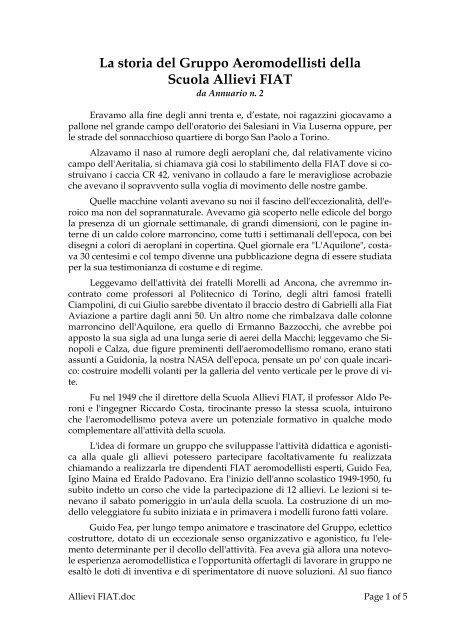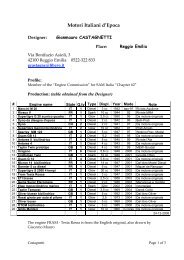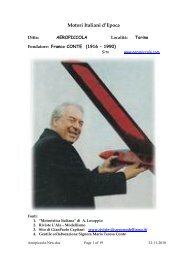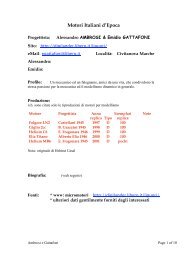La storia del Gruppo Aeromodellisti della Scuola ... - Italian Engines
La storia del Gruppo Aeromodellisti della Scuola ... - Italian Engines
La storia del Gruppo Aeromodellisti della Scuola ... - Italian Engines
Create successful ePaper yourself
Turn your PDF publications into a flip-book with our unique Google optimized e-Paper software.
<strong>La</strong> <strong>storia</strong> <strong>del</strong> <strong>Gruppo</strong> Aeromo<strong>del</strong>listi <strong>del</strong>la<br />
<strong>Scuola</strong> Allievi FIAT<br />
da Annuario n. 2<br />
Eravamo alla fine degli anni trenta e, d’estate, noi ragazzini giocavamo a<br />
pallone nel grande campo <strong>del</strong>l'oratorio dei Salesiani in Via Luserna oppure, per<br />
le strade <strong>del</strong> sonnacchioso quartiere di borgo San Paolo a Torino.<br />
Alzavamo il naso al rumore degli aeroplani che, dal relativamente vicino<br />
campo <strong>del</strong>l'Aeritalia, si chiamava già cosi lo stabilimento <strong>del</strong>la FIAT dove si costruivano<br />
i caccia CR 42, venivano in collaudo a fare le meravigliose acrobazie<br />
che avevano il sopravvento sulla voglia di movimento <strong>del</strong>le nostre gambe.<br />
Quelle macchine volanti avevano su noi il fascino <strong>del</strong>l'eccezionalità, <strong>del</strong>l'eroico<br />
ma non <strong>del</strong> soprannaturale. Avevamo già scoperto nelle edicole <strong>del</strong> borgo<br />
la presenza di un giornale settimanale, di grandi dimensioni, con le pagine interne<br />
di un caldo colore marroncino, come tutti i settimanali <strong>del</strong>l'epoca, con bei<br />
disegni a colori di aeroplani in copertina. Quel giornale era "L'Aquilone", costava<br />
30 centesimi e col tempo divenne una pubblicazione degna di essere studiata<br />
per la sua testimonianza di costume e di regime.<br />
Leggevamo <strong>del</strong>l'attività dei fratelli Morelli ad Ancona, che avremmo incontrato<br />
come professori al Politecnico di Torino, degli altri famosi fratelli<br />
Ciampolini, di cui Giulio sarebbe diventato il braccio destro di Gabrielli alla Fiat<br />
Aviazione a partire dagli anni 50. Un altro nome che rimbalzava dalle colonne<br />
marroncino <strong>del</strong>l'Aquilone, era quello di Ermanno Bazzocchi, che avrebbe poi<br />
apposto la sua sigla ad una lunga serie di aerei <strong>del</strong>la Macchi; leggevamo che Sinopoli<br />
e Calza, due figure preminenti <strong>del</strong>l'aeromo<strong>del</strong>lismo romano, erano stati<br />
assunti a Guidonia, la nostra NASA <strong>del</strong>l'epoca, pensate un po' con quale incarico:<br />
costruire mo<strong>del</strong>li volanti per la galleria <strong>del</strong> vento verticale per le prove di vite.<br />
Fu nel 1949 che il direttore <strong>del</strong>la <strong>Scuola</strong> Allievi FIAT, il professor Aldo Peroni<br />
e l'ingegner Riccardo Costa, tirocinante presso la stessa scuola, intuirono<br />
che l'aeromo<strong>del</strong>lismo poteva avere un potenziale formativo in qualche modo<br />
complementare all'attività <strong>del</strong>la scuola.<br />
L'idea di formare un gruppo che sviluppasse l'attività didattica e agonistica<br />
alla quale gli allievi potessero partecipare facoltativamente fu realizzata<br />
chiamando a realizzarla tre dipendenti FIAT aeromo<strong>del</strong>listi esperti, Guido Fea,<br />
Igino Maina ed Eraldo Padovano. Era l'inizio <strong>del</strong>l'anno scolastico 1949-1950, fu<br />
subito indetto un corso che vide la partecipazione di 12 allievi. Le lezioni si tenevano<br />
il sabato pomeriggio in un'aula <strong>del</strong>la scuola. <strong>La</strong> costruzione di un mo<strong>del</strong>lo<br />
veleggiatore fu subito iniziata e in primavera i mo<strong>del</strong>li furono fatti volare.<br />
Guido Fea, per lungo tempo animatore e trascinatore <strong>del</strong> <strong>Gruppo</strong>, eclettico<br />
costruttore, dotato di un eccezionale senso organizzativo e agonistico, fu l'elemento<br />
determinante per il decollo <strong>del</strong>l'attività. Fea aveva già allora una notevole<br />
esperienza aeromo<strong>del</strong>listica e l'opportunità offertagli di lavorare in gruppo ne<br />
esaltò le doti di inventiva e di sperimentatore di nuove soluzioni. Al suo fianco<br />
Allievi FIAT.doc Page 1 of 5
Igino Maina portò da subito il suo costante contributo tecnico con soluzioni innovative<br />
e le sue capacità costruttive furono utilissime per lo sviluppo <strong>del</strong>le<br />
numerose idee che sorgevano da un così intenso lavoro di gruppo.<br />
Intanto l'attività agonistica col nome <strong>Gruppo</strong> Aeromo<strong>del</strong>listi <strong>Scuola</strong> Allievi<br />
FIAT era iniziata nel 1950.<br />
Quell'anno si iniziò con una vittoria di Guido Fea alla Coppa Tevere a<br />
Roma grazie ad un mo<strong>del</strong>lo a elastico con un nuovo sistema a doppia matassa<br />
sviluppato in base alle idee circolate nell'ambiente aeromo<strong>del</strong>listico internazionale.<br />
<strong>La</strong> durata totale di quattro voli fu di 12'35". <strong>La</strong> squadra <strong>del</strong>la <strong>Scuola</strong> Allievi<br />
FIAT si classificò quarta su diciotto squadre partecipanti. L'anno finì al Concorso<br />
Nazionale di Bologna dove il <strong>Gruppo</strong> FIAT conquistò il titolo a squadre e per<br />
Eraldo Padovano anche il titolo di Campione <strong>Italian</strong>o dei motomo<strong>del</strong>li.<br />
Nel 1952 sull'aeroporto di Fiumicino Guido Fea conquistò il titolo di Campione<br />
<strong>Italian</strong>o dei mo<strong>del</strong>li elastico ma, evento ancor più significativo, fu l'affermazione<br />
di Sergio Cattaneo con i motomo<strong>del</strong>li; era la prima affermazione di<br />
questo livello conseguita da un allievo. <strong>La</strong> scuola iniziava a dare velocemente<br />
buoni frutti.<br />
Nel 1958 le squadre <strong>del</strong>la <strong>Scuola</strong> Allievi FIAT conquistarono il titolo di<br />
Campione <strong>Italian</strong>o in entrambe le categorie, Senior e Junior.<br />
Per intanto, con meritata soddisfazione, pensiamo al consuntivo ad oggi<br />
<strong>del</strong>la nostra attività agonistica che possiamo esprimere in poche cifre.<br />
Gli aeromo<strong>del</strong>listi <strong>del</strong> <strong>Gruppo</strong>, dalla fondazione ad oggi, hanno conquistato<br />
40 volte il titolo di Campione <strong>Italian</strong>o, 43 volte si sono piazzati al secondo posto<br />
e 32 volte al terzo.<br />
Dopo mezzo secolo passato con il naso all'insù la nostra <strong>storia</strong> può essere<br />
solo un buon auspicio per gli anni che verranno. Perché il futuro risiede nella<br />
nostra capacità di continuare con la stessa determinazione ancora più rafforzata<br />
dalla responsabilità che sentiamo per il nostro passato.<br />
L'articolo e la foto sono stati tratti, per gentile concessione, dalla pubblicazione<br />
edita per il 500 anniversario <strong>del</strong> <strong>Gruppo</strong> Aeromo<strong>del</strong>listi <strong>del</strong>l'Associazione<br />
ex Allievi FIAT. Così pure il disegno e la didascalia <strong>del</strong> Planoforo a pag.<br />
38.<br />
Allievi FIAT.doc Page 2 of 5
1950 - Guido Fea sul campo <strong>del</strong>l'Urbe a Roma. È la prima partecipazione<br />
<strong>del</strong> <strong>Gruppo</strong> Aeromo<strong>del</strong>listi <strong>del</strong>la <strong>Scuola</strong> Centrale FIAT alle gare nazionali. Fea<br />
conquista un ambitissimo primo posto, iniziando così una lunga serie di successi.<br />
Il cassone per il trasporto dei mo<strong>del</strong>li conteneva tutti i mo<strong>del</strong>li <strong>del</strong>la<br />
squadra ed era così ingombrante che non entrava nello scompartimento <strong>del</strong> treno<br />
e doveva essere sistemato sul carro bagagli<br />
1950 - Guido Fea on the Urbe field in Rome. It was the first time the Aeromo<strong>del</strong>ing<br />
Group of the FIAT School had taken part in the national championships.<br />
Fea won a fiercely contested first place, starting off a long string of successes.<br />
The trunk was used for the transport of all the team's mo<strong>del</strong>s. It was so<br />
bulky that it would not fit in the train compartment and had to be stowed in<br />
the baggage car.<br />
Allievi FIAT.doc Page 3 of 5
The History of the<br />
FIAT School Aeromo<strong>del</strong>ing Group<br />
It was the end of the thirties and in the summer we would play football<br />
with other kids on the big pitch at the “Oratorio Salesiano” or in the streets of<br />
the sleepy San Paolo district in Turin.<br />
We would lift our faces at the sound of the airplanes from the nearby field<br />
where Aeritalia - the FIAT factory that built the CR 42 fighters - tested its aircraft,<br />
and their aerobatics prevailed over the need to move our legs.<br />
For us, those flying machines had the fascination of the exceptional, the<br />
heroic, but not the supernatural. In our local news-stands we had already seen a<br />
large weekly magazine, whose inside pages were in a warm brown color, like<br />
all the weeklies of the time, with fine color drawings of airplanes on the cover. It<br />
was called "L'Aquilone", cost 30 cents and over the years became a journal<br />
worth studying as a window on <strong>Italian</strong> society and the regime.<br />
We read of the exploits of the Morelli brothers in Ancona, whom we later<br />
met as teachers at the Turin Politecnico, and the other famous brothers of whom<br />
one – Giulio Ciampolini - was to become Gabrielli's number two at Fiat Aviation<br />
in the 1950s. Another name that stood out from the brown columns of the<br />
Aquilone was Ermanno Bazzocchi, who would later put his name to a long series<br />
of planes built by Macchi. We read that Sinopoli and Calza, two leaders of<br />
aero-mo<strong>del</strong>ing in Rome, had been employed at Guidonia - our version of NASA<br />
at the time - to do guess what? To build flying mo<strong>del</strong>s to put in the vertical<br />
wind tunnels for roll testing.<br />
It was in 1949 that Aldo Peroni, headmaster of the FIAT School, and Riccardo<br />
Costa, a student teacher there, had the idea that aero-mo<strong>del</strong>ing might<br />
have a formative value that would complement normal school education. The<br />
initiative of forming a group to develop teaching and competitive activity as an<br />
option for pupils took shape with the summoning of three aero-mo<strong>del</strong>ing experts<br />
employed by FIAT - Guido Fea, Igino Maina and Eraldo Padovano. At the<br />
beginning of the 1949-50 school year a course was started with 12 pupils attending.<br />
Lessons were held on Saturday afternoons in a classroom of the school.<br />
Work started immediately on a mo<strong>del</strong> glider and the first flights took place in<br />
the spring.<br />
Guido Fea, for a long time the driving force and guiding spirit of the<br />
group, an eclectic constructor endowed with exceptional organizational and<br />
competitive abilities, was the decisive factor in the successful development of<br />
the activity. Even then he had considerable aero-mo<strong>del</strong>ing experience, and the<br />
offer of a chance to work with a group enhanced his inventiveness and desire to<br />
experiment with new ideas.<br />
Alongside him, Igino Maina provided an immediate and constant technical<br />
contribution with innovative design solutions. His ability in construction<br />
was invaluable for developing the many ideas thrown up by such intensive<br />
group work.<br />
Allievi FIAT.doc Page 4 of 5
In 1950 the group began taking part in competitions, under the name FIAT<br />
School Aero Mo<strong>del</strong>ing Group. In that year Guido Fea scored a victory at the<br />
Coppa Tevere (Tiber Cup) in Rome, with a double-band rubber-powered mo<strong>del</strong><br />
developed on the basis of ideas bounced around on the international mo<strong>del</strong>ing<br />
grapevine. The total duration of four flights was 12' 35". The group as a whole<br />
was placed fourth overall out of eighteen teams.<br />
The year closed with the National Championships in Bologna, where the<br />
FIAT group won the team award and Eraldo Padovano took the <strong>Italian</strong> gaspowered<br />
title.<br />
At Fiumicino airport in 1952 Guido Fea won the national title for rubberpowered<br />
mo<strong>del</strong>s, but even more striking was the success of Sergio Cattaneo<br />
with gas-powered mo<strong>del</strong>s. It was the first time a pupil had gone so far at this<br />
level. The school was rapidly making a name for itself.<br />
In 1958 the FIAT School won the title of <strong>Italian</strong> Champions in both categories<br />
- Junior as well as Senior.<br />
In the meantime, we can reflect with well-earned satisfaction on the record<br />
of our competitive activity over the years. A few figures will suffice. Since the<br />
Group's foundation its members have won the title of <strong>Italian</strong> Champion 40<br />
times, come second 43 times and registered 32 third places.<br />
After half a century of upturned faces our history can only augur well for<br />
the years to come. Our future lies in our ability to continue with the same determination,<br />
strengthened by the responsibility we feel for the past.<br />
The article, the picture and the Planophore drawing and caption at page<br />
38 have been taken, with kind concession, from the book edited for the 50th anniversary<br />
of the Group of the FIAT ex-Pupils Association.<br />
Allievi FIAT.doc Page 5 of 5






